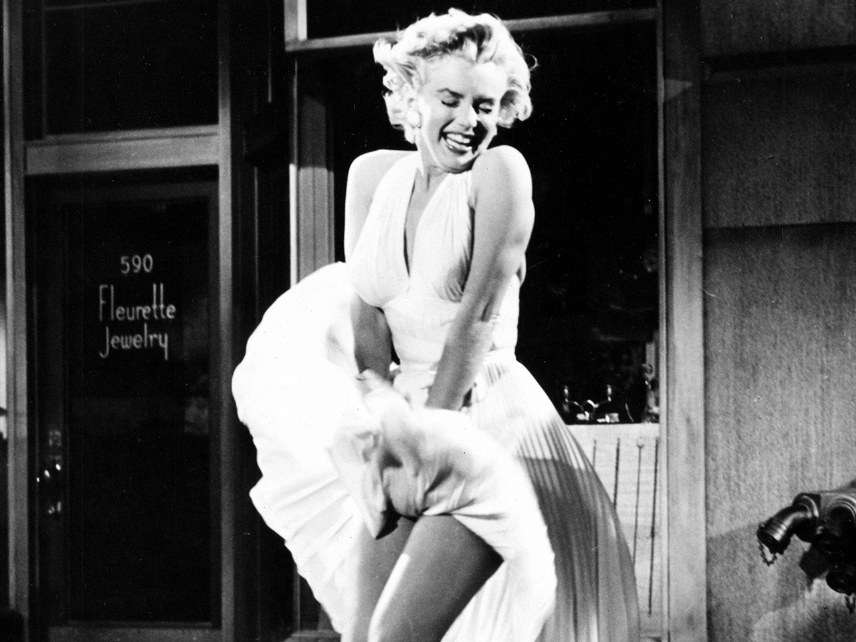Spend Christmas Reminiscing About Hollywood's Golden Age
Documentaries explore film industry's history, Marilyn Monroe's past.
'The Seven Year Itch,' 20th Century Fox America in Color: Hollywood's Golden Age
. Smithsonian Channel. Sunday, December 23, 8 p.m.- Marilyn Monroe for Sale. Smithsonian Channel. Sunday, December 23, 9 p.m.
If you want to be all Grinchy about it, you could grumble, in the age of #MeToo, how could the Smithsonian Channel make two, count 'em, two documentaries about Old Hollywood without a single mention of the casting couch?
But if you're more of a God-bless-us-every-one type, it's maybe reasonable to consider America in Color: Hollywood's Golden Age and Marilyn Monroe for Sale as pleasantly fluffy reminiscences of the days when "big screen" meant not a 65-inch TV but something the size of a wall—or three walls, if you're talking Cinerama—upon which Attack of the 50-Foot Woman looked almost literal.
The series America in Color is generally less about hard-core historical analysis than a dip into 20th-century nostalgia with a fuzzy overlay of sociology. And on a Sunday evening two days before Christmas, when most network programming has dissolved into a mess of reruns and reindeer games, that's not a bad alternative.
And in some ways, this episode is a bit more serious than others, touching on some interesting elements of Hollywood economics—in particular, a segment that deftly explains why Hollywood, rather than West Orange, N.J., became the center of the American film industry.
Production companies fled to the west coast in 1910 to escape Thomas Edison's goon squads, which were belligerently enforcing his contention that his patents on film stock, cameras, and projectors essentially prohibited anybody else from making or exhibiting movies. The Supreme Court eventually ruled against him, but by then the film industry was hopelessly addicted to Southern California's mild weather and eminently filmable beaches and mountains.
There's much more, like the war between actors and directors and the skinflint studio system created by producers, and how the challenge from television pushed the movie industry into widescreen technology like Cinerama and CinemaScope so that movie theaters could offer larger-than-life panoramas that TV didn't have.
But the key to America in Color has always been its crackerjack archival researchers and their ability to track down footage long lost or forgotten. They're at their best here: Footage of two very different versions of "Happy Birthday" being sung to American presidents by first Shirley Temple and later Marilyn Monroe; home movies of Vivian Leigh waving a cigarette in the air as she chats up Clark Gable on the set of Gone With The Wind; a startlingly explicit and long suppressed nude swimming scene by Maureen O'Sullivan's body double in the 1934 film Tarzan And His Mate; shots of director John Ford in the early days of World War II, carrying out private anti-submarine patrols on his private yacht while he and his studio pals wore rented navy uniforms.
Nothing, though, tops a segment on Jackie, the third of MGM's signature opening-credit lions and the first to roar on screen when talkies came in. Jackie was so popular that she triggered an act of promotional excess memorable even for Hollywood: MGM built her a glass-walled airplane to tour the United States. The plane promptly crashed in Arizona; when studio bosses got word, their first question was, "How's the lion?"
Marilyn Monroe for Sale is built around an auction of over a thousand pieces of Monroe memorabilia, everything from a hotel notepad on which she jotted the cryptic message "Keep the balloon and dare to worry" to the sheer silk dress studded with thousands of crystal rhinestones in which she sang her determinedly unwholesome version of "Happy Birthday" to John F. Kennedy.
(By the way, if you ever thought she looked, um, naked in that film clip, that was the point. Designer Bob Mackie discloses that the dress was created with "the idea that Marilyn would be absolutely nude with just diamonds on her as she walked out." Mission definitely accomplished.)
The documentary uses some of the auction items to relate anecdotes from her life, which makes it lively but far from definitive. Photos from the set of The Seven Year Itch, a subway grate, blowing her skirt high enough to reveal the promised land, anchor a segment on her marriage to Joe DiMaggio, which ended over the scene.
Another notorious photo—the pre-celebrity nude shot that surfaced in 1952 and nearly wrecked her blooming film career—is a reminder of her often-overlooked sly wit: Asked what she had on during the shoot, her deadpan reply was: "The radio."
But the years toward the end of Monroe's life, a blur of broken marriages and failed movies, had less place for wit. Marilyn Monroe for Sale doesn't dwell on that time, though it does mention an unusual auction item: A specially bound collection of the works of Arthur Miller, her third and final husband, who gave it to her as a present. It presumably does not include the diary she found open one night in which he said she was "disappointing" and stopped just short of calling her a bimbo.
Others, like her handwritten recipe for turkey dressing, are more mundane. It's tempting to put auction lot No. 14, a prescription bottle made out to Mrs. A. Miller, in that category, unless you know the end of the Marilyn story, the escalating cycle of amphetamines and barbiturates that ran out in her bedroom on a sultry August night in 1962. She was 36.

